Workplace Safety: Compliance Strategies for OSHA Regulations
VerifiedAdded on 2020/04/15
|5
|1089
|197
AI Summary
The assignment discusses occupational health and safety practices aimed at protecting human resources and facilities in the workplace. It presents a case where an OSHA compliance officer's visit prompts the company to adopt strategies to reduce penalties and ensure compliance. Key approaches include leveraging clean OSHA records, qualifying for size reduction, demonstrating good faith through new safety programs, and immediate corrective actions like proper labeling and providing personal protective equipment (PPE). Long-term strategies involve maintaining a chemical inventory, implementing lockout/tagout practices, training workers on safety protocols, and enhancing fire safety measures. The importance of adhering to OSHA's guidelines to prevent future citations is emphasized.
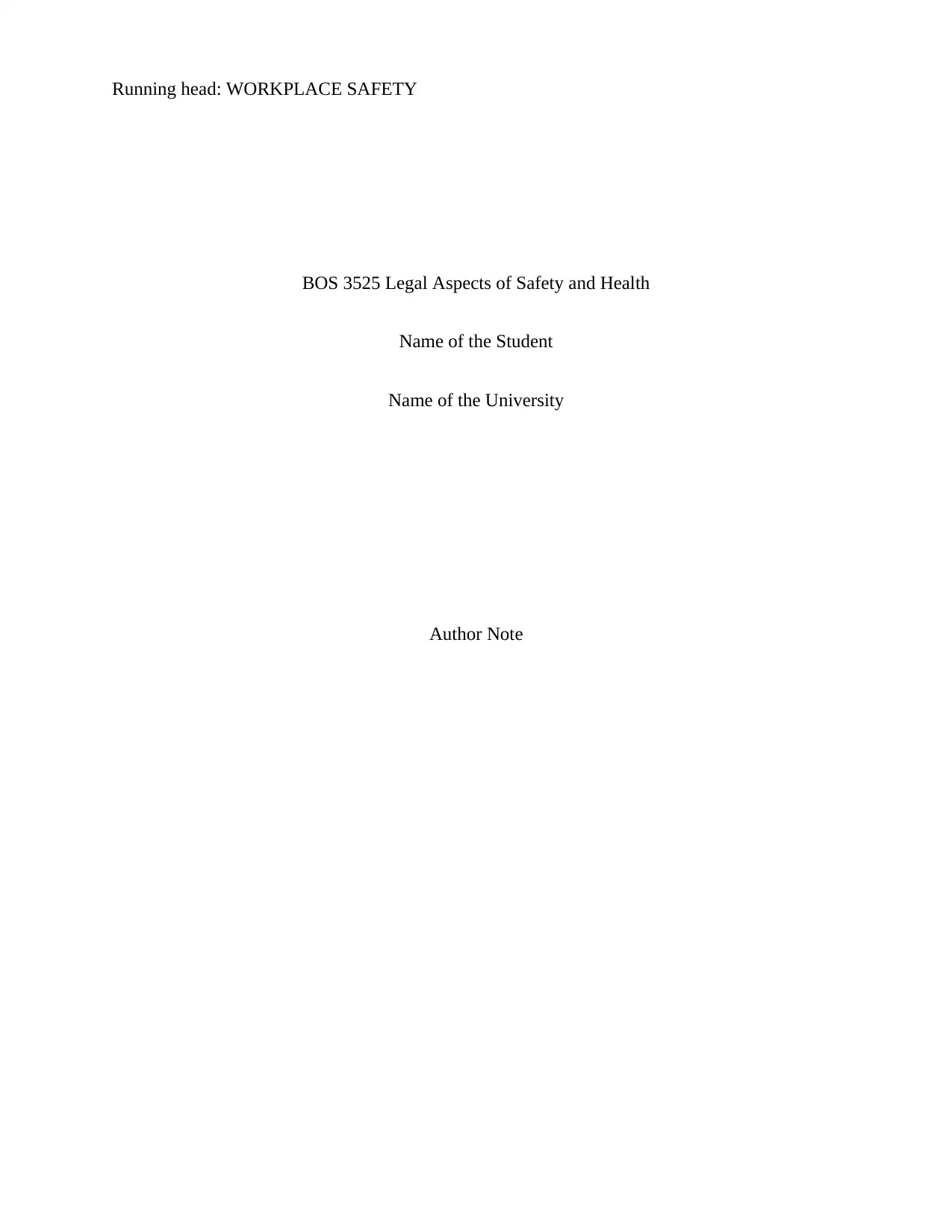
Running head: WORKPLACE SAFETY
BOS 3525 Legal Aspects of Safety and Health
Name of the Student
Name of the University
Author Note
BOS 3525 Legal Aspects of Safety and Health
Name of the Student
Name of the University
Author Note
Paraphrase This Document
Need a fresh take? Get an instant paraphrase of this document with our AI Paraphraser
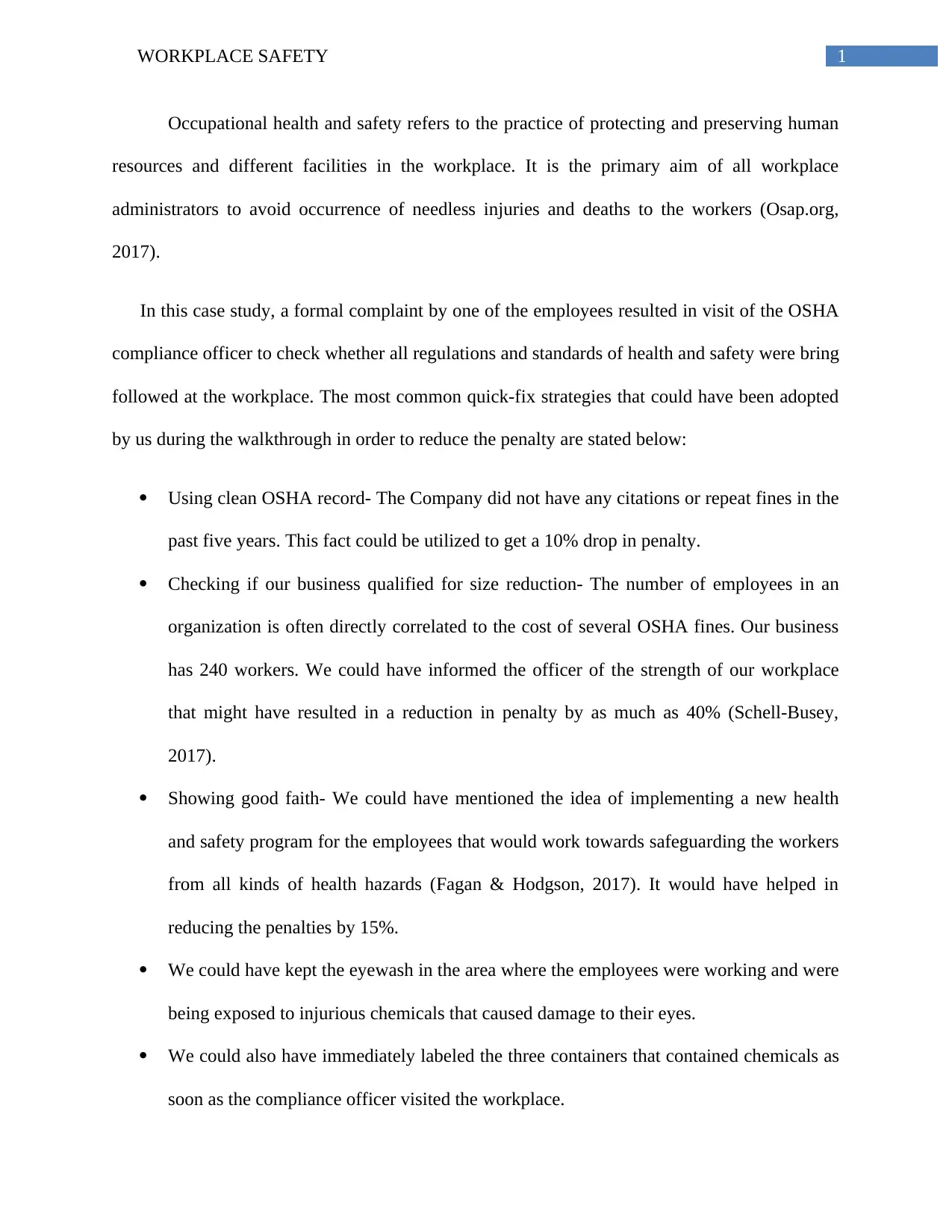
1WORKPLACE SAFETY
Occupational health and safety refers to the practice of protecting and preserving human
resources and different facilities in the workplace. It is the primary aim of all workplace
administrators to avoid occurrence of needless injuries and deaths to the workers (Osap.org,
2017).
In this case study, a formal complaint by one of the employees resulted in visit of the OSHA
compliance officer to check whether all regulations and standards of health and safety were bring
followed at the workplace. The most common quick-fix strategies that could have been adopted
by us during the walkthrough in order to reduce the penalty are stated below:
Using clean OSHA record- The Company did not have any citations or repeat fines in the
past five years. This fact could be utilized to get a 10% drop in penalty.
Checking if our business qualified for size reduction- The number of employees in an
organization is often directly correlated to the cost of several OSHA fines. Our business
has 240 workers. We could have informed the officer of the strength of our workplace
that might have resulted in a reduction in penalty by as much as 40% (Schell-Busey,
2017).
Showing good faith- We could have mentioned the idea of implementing a new health
and safety program for the employees that would work towards safeguarding the workers
from all kinds of health hazards (Fagan & Hodgson, 2017). It would have helped in
reducing the penalties by 15%.
We could have kept the eyewash in the area where the employees were working and were
being exposed to injurious chemicals that caused damage to their eyes.
We could also have immediately labeled the three containers that contained chemicals as
soon as the compliance officer visited the workplace.
Occupational health and safety refers to the practice of protecting and preserving human
resources and different facilities in the workplace. It is the primary aim of all workplace
administrators to avoid occurrence of needless injuries and deaths to the workers (Osap.org,
2017).
In this case study, a formal complaint by one of the employees resulted in visit of the OSHA
compliance officer to check whether all regulations and standards of health and safety were bring
followed at the workplace. The most common quick-fix strategies that could have been adopted
by us during the walkthrough in order to reduce the penalty are stated below:
Using clean OSHA record- The Company did not have any citations or repeat fines in the
past five years. This fact could be utilized to get a 10% drop in penalty.
Checking if our business qualified for size reduction- The number of employees in an
organization is often directly correlated to the cost of several OSHA fines. Our business
has 240 workers. We could have informed the officer of the strength of our workplace
that might have resulted in a reduction in penalty by as much as 40% (Schell-Busey,
2017).
Showing good faith- We could have mentioned the idea of implementing a new health
and safety program for the employees that would work towards safeguarding the workers
from all kinds of health hazards (Fagan & Hodgson, 2017). It would have helped in
reducing the penalties by 15%.
We could have kept the eyewash in the area where the employees were working and were
being exposed to injurious chemicals that caused damage to their eyes.
We could also have immediately labeled the three containers that contained chemicals as
soon as the compliance officer visited the workplace.
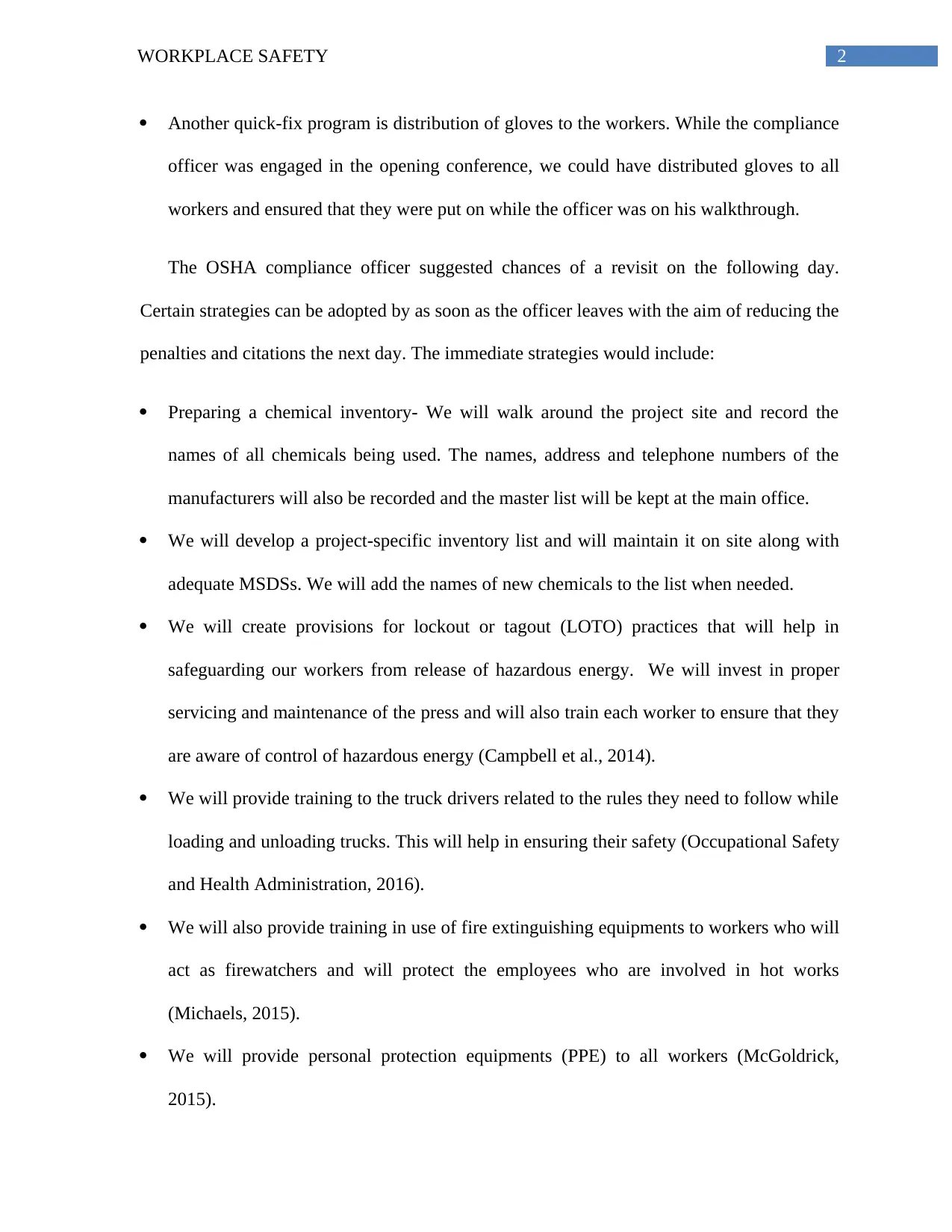
2WORKPLACE SAFETY
Another quick-fix program is distribution of gloves to the workers. While the compliance
officer was engaged in the opening conference, we could have distributed gloves to all
workers and ensured that they were put on while the officer was on his walkthrough.
The OSHA compliance officer suggested chances of a revisit on the following day.
Certain strategies can be adopted by as soon as the officer leaves with the aim of reducing the
penalties and citations the next day. The immediate strategies would include:
Preparing a chemical inventory- We will walk around the project site and record the
names of all chemicals being used. The names, address and telephone numbers of the
manufacturers will also be recorded and the master list will be kept at the main office.
We will develop a project-specific inventory list and will maintain it on site along with
adequate MSDSs. We will add the names of new chemicals to the list when needed.
We will create provisions for lockout or tagout (LOTO) practices that will help in
safeguarding our workers from release of hazardous energy. We will invest in proper
servicing and maintenance of the press and will also train each worker to ensure that they
are aware of control of hazardous energy (Campbell et al., 2014).
We will provide training to the truck drivers related to the rules they need to follow while
loading and unloading trucks. This will help in ensuring their safety (Occupational Safety
and Health Administration, 2016).
We will also provide training in use of fire extinguishing equipments to workers who will
act as firewatchers and will protect the employees who are involved in hot works
(Michaels, 2015).
We will provide personal protection equipments (PPE) to all workers (McGoldrick,
2015).
Another quick-fix program is distribution of gloves to the workers. While the compliance
officer was engaged in the opening conference, we could have distributed gloves to all
workers and ensured that they were put on while the officer was on his walkthrough.
The OSHA compliance officer suggested chances of a revisit on the following day.
Certain strategies can be adopted by as soon as the officer leaves with the aim of reducing the
penalties and citations the next day. The immediate strategies would include:
Preparing a chemical inventory- We will walk around the project site and record the
names of all chemicals being used. The names, address and telephone numbers of the
manufacturers will also be recorded and the master list will be kept at the main office.
We will develop a project-specific inventory list and will maintain it on site along with
adequate MSDSs. We will add the names of new chemicals to the list when needed.
We will create provisions for lockout or tagout (LOTO) practices that will help in
safeguarding our workers from release of hazardous energy. We will invest in proper
servicing and maintenance of the press and will also train each worker to ensure that they
are aware of control of hazardous energy (Campbell et al., 2014).
We will provide training to the truck drivers related to the rules they need to follow while
loading and unloading trucks. This will help in ensuring their safety (Occupational Safety
and Health Administration, 2016).
We will also provide training in use of fire extinguishing equipments to workers who will
act as firewatchers and will protect the employees who are involved in hot works
(Michaels, 2015).
We will provide personal protection equipments (PPE) to all workers (McGoldrick,
2015).
⊘ This is a preview!⊘
Do you want full access?
Subscribe today to unlock all pages.

Trusted by 1+ million students worldwide
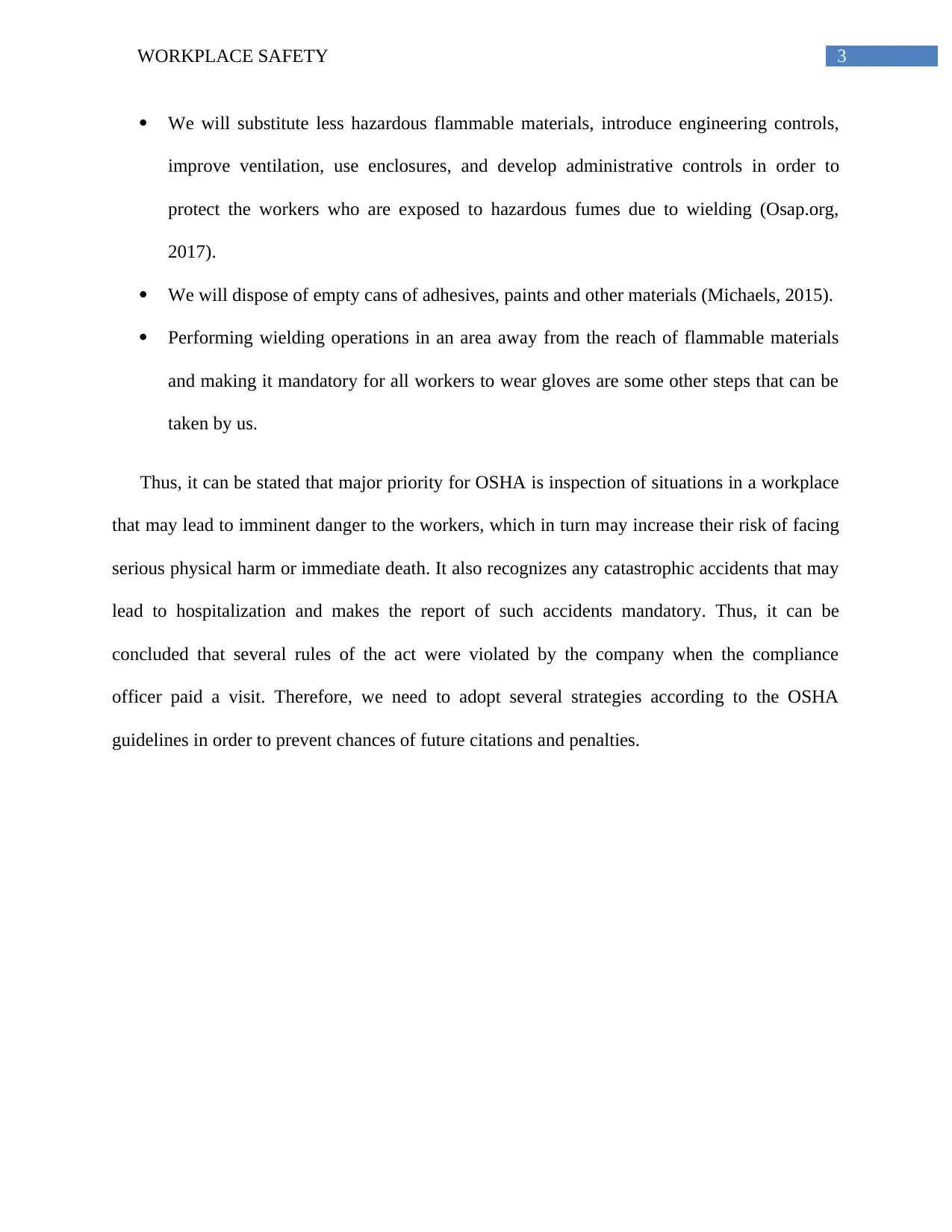
3WORKPLACE SAFETY
We will substitute less hazardous flammable materials, introduce engineering controls,
improve ventilation, use enclosures, and develop administrative controls in order to
protect the workers who are exposed to hazardous fumes due to wielding (Osap.org,
2017).
We will dispose of empty cans of adhesives, paints and other materials (Michaels, 2015).
Performing wielding operations in an area away from the reach of flammable materials
and making it mandatory for all workers to wear gloves are some other steps that can be
taken by us.
Thus, it can be stated that major priority for OSHA is inspection of situations in a workplace
that may lead to imminent danger to the workers, which in turn may increase their risk of facing
serious physical harm or immediate death. It also recognizes any catastrophic accidents that may
lead to hospitalization and makes the report of such accidents mandatory. Thus, it can be
concluded that several rules of the act were violated by the company when the compliance
officer paid a visit. Therefore, we need to adopt several strategies according to the OSHA
guidelines in order to prevent chances of future citations and penalties.
We will substitute less hazardous flammable materials, introduce engineering controls,
improve ventilation, use enclosures, and develop administrative controls in order to
protect the workers who are exposed to hazardous fumes due to wielding (Osap.org,
2017).
We will dispose of empty cans of adhesives, paints and other materials (Michaels, 2015).
Performing wielding operations in an area away from the reach of flammable materials
and making it mandatory for all workers to wear gloves are some other steps that can be
taken by us.
Thus, it can be stated that major priority for OSHA is inspection of situations in a workplace
that may lead to imminent danger to the workers, which in turn may increase their risk of facing
serious physical harm or immediate death. It also recognizes any catastrophic accidents that may
lead to hospitalization and makes the report of such accidents mandatory. Thus, it can be
concluded that several rules of the act were violated by the company when the compliance
officer paid a visit. Therefore, we need to adopt several strategies according to the OSHA
guidelines in order to prevent chances of future citations and penalties.
Paraphrase This Document
Need a fresh take? Get an instant paraphrase of this document with our AI Paraphraser
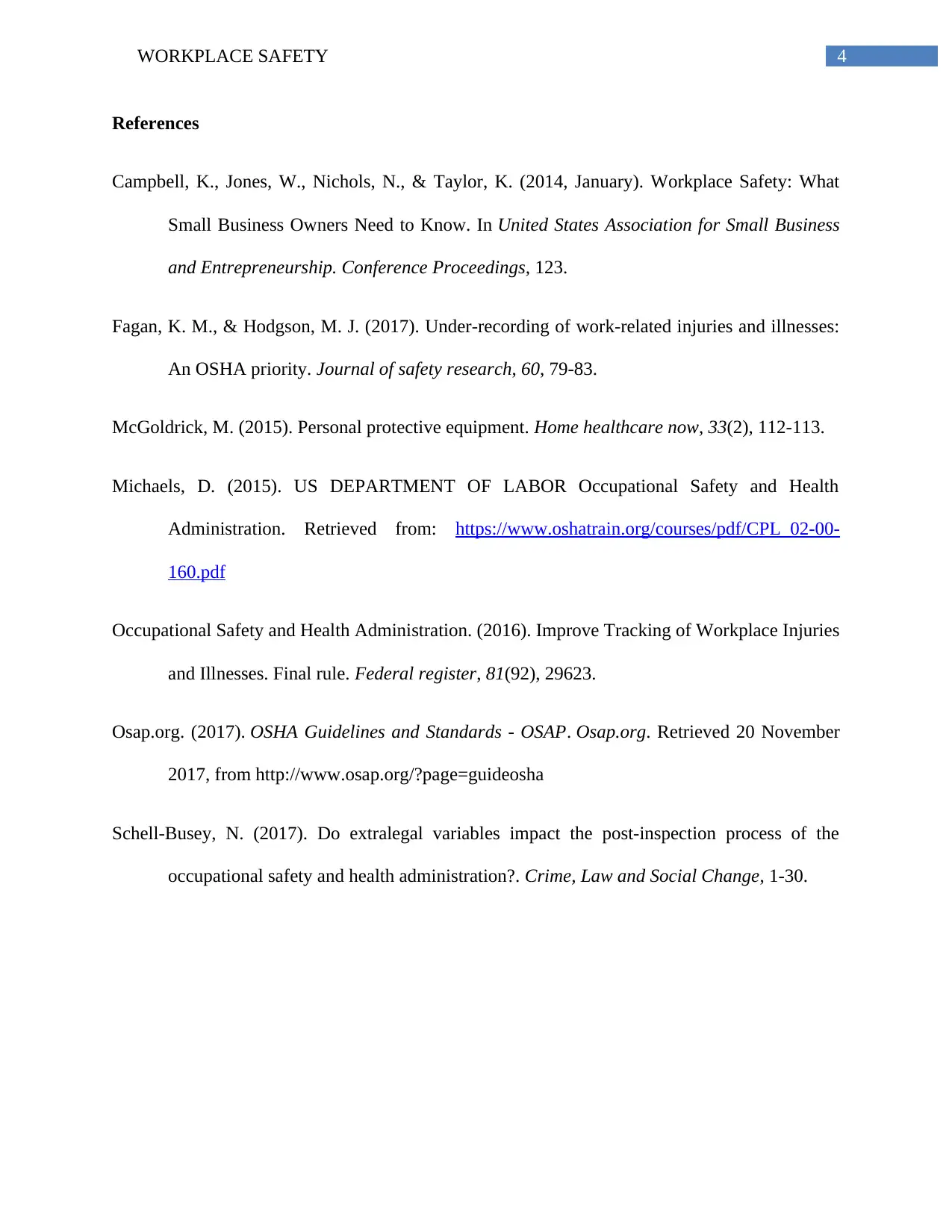
4WORKPLACE SAFETY
References
Campbell, K., Jones, W., Nichols, N., & Taylor, K. (2014, January). Workplace Safety: What
Small Business Owners Need to Know. In United States Association for Small Business
and Entrepreneurship. Conference Proceedings, 123.
Fagan, K. M., & Hodgson, M. J. (2017). Under-recording of work-related injuries and illnesses:
An OSHA priority. Journal of safety research, 60, 79-83.
McGoldrick, M. (2015). Personal protective equipment. Home healthcare now, 33(2), 112-113.
Michaels, D. (2015). US DEPARTMENT OF LABOR Occupational Safety and Health
Administration. Retrieved from: https://www.oshatrain.org/courses/pdf/CPL_02-00-
160.pdf
Occupational Safety and Health Administration. (2016). Improve Tracking of Workplace Injuries
and Illnesses. Final rule. Federal register, 81(92), 29623.
Osap.org. (2017). OSHA Guidelines and Standards - OSAP. Osap.org. Retrieved 20 November
2017, from http://www.osap.org/?page=guideosha
Schell-Busey, N. (2017). Do extralegal variables impact the post-inspection process of the
occupational safety and health administration?. Crime, Law and Social Change, 1-30.
References
Campbell, K., Jones, W., Nichols, N., & Taylor, K. (2014, January). Workplace Safety: What
Small Business Owners Need to Know. In United States Association for Small Business
and Entrepreneurship. Conference Proceedings, 123.
Fagan, K. M., & Hodgson, M. J. (2017). Under-recording of work-related injuries and illnesses:
An OSHA priority. Journal of safety research, 60, 79-83.
McGoldrick, M. (2015). Personal protective equipment. Home healthcare now, 33(2), 112-113.
Michaels, D. (2015). US DEPARTMENT OF LABOR Occupational Safety and Health
Administration. Retrieved from: https://www.oshatrain.org/courses/pdf/CPL_02-00-
160.pdf
Occupational Safety and Health Administration. (2016). Improve Tracking of Workplace Injuries
and Illnesses. Final rule. Federal register, 81(92), 29623.
Osap.org. (2017). OSHA Guidelines and Standards - OSAP. Osap.org. Retrieved 20 November
2017, from http://www.osap.org/?page=guideosha
Schell-Busey, N. (2017). Do extralegal variables impact the post-inspection process of the
occupational safety and health administration?. Crime, Law and Social Change, 1-30.
1 out of 5
Related Documents
Your All-in-One AI-Powered Toolkit for Academic Success.
+13062052269
info@desklib.com
Available 24*7 on WhatsApp / Email
![[object Object]](/_next/static/media/star-bottom.7253800d.svg)
Unlock your academic potential
Copyright © 2020–2025 A2Z Services. All Rights Reserved. Developed and managed by ZUCOL.



